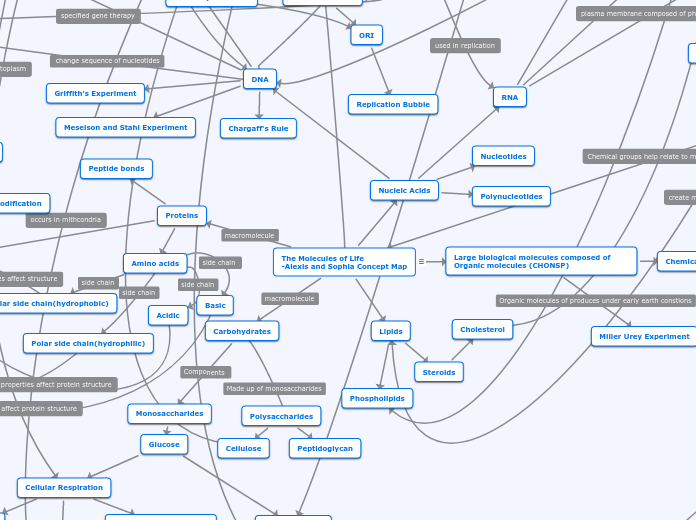Eukaryotic cells
Plant Cell
Golgi body
Vesicles
-Central Vacuoles: serve as repository for inorganic ions (found in mature plant cells)
Chloroplasts
Stroma (internal fluid)
equivalent of matrix in mitochondria
Inner membrane spaces
Thylakoid
synthesize proteins
stores genetic material
Granum
stack of thylakoid
Animal Cell
Mitochondria
Production of ATP by breaking down complex molecules
intermembrane space
Matrix
Inner membrane (folded into cristae)
DNA
free ribosomes
make proteins
Outside of ER/ nuclear envelope: bound ribosomes
Cytosol: free ribosomes
Complexes of rRNA and protein
Endomembrane system
Endoplasmic Reticulum
Continuous with nuclear envelope
Smooth ER
-No attached ribosomes
-Synthesizes lipids
-Metabolizes carbs
-Detoxifies drugs and poison
-Stores Calcium ions
Rough ER
-Surface studded with ribosomes
-Bound ribosomes secrete glycoproteins
-Distribute transport vesicles
-Known as membrane factory of cell
Vacuoles
-Food Vacuoles: when cells engulf food or other particles
-Contractile Vacuoles: pumps excess water out of cell (found in freshwater protists)
Lysosomes
-packed with enzymes
-function in acid pH
-H+ pumped to maintain low pH
Phagocytosis
Golgi Apparatus
-Made of different sacs
-Vesicles transported from ER to out of Golgi apparatus
Nucleus
Double membrane: Nuclear envelope
Lamina: lines in the inner surface that protect the integrity
Pores: help transport molecules in and out of cell
Nucleolus
Site of rRNA synthesis
- organized into chromosomes
- DNA + Proteins = chromatin
ORIGINS OF LIFE
pre-mRNA--> mRNA
Introns spliced out
Alternative splicing
1 gene codes for 1+ proteins
5' guanine cap
3' polyA tail
Protein P Phosphotase (PP)
Eukaryotic Transcription
Transcription Factors
Specific
Attach to Enhancer
General
Attach to promoter/proximal control element
Promoter
Transcription Initiation Complex
pre-mRNA
Control Element
Distal
Enhancer
Increased Expression
Proximal
Basal Level Expression
Low level of protein production
Prokaryotic Transcription
Operon
Structural Genes
promoter
RNA Polymerase
operator
Glucose present
Activator
Turns gene expression on
Repressor
Turns gene expression off
Cell Signaling
Reception
Relay Molecule
Transduction
Nuclear Response Pathway
Receptor Activated
Receptor activates phosphorylation Cascade
Activation of a Transcription Factor
Transcription
Gene Expression
G-Protein and cAMP Pathway
G-Protein Coupled Receptor (GPCR)
Inactive G-Protein
Activated G-Protein
Adenylyl Cyclase
cAMP Formed
AMP Formed
Protein Kinase A
Phosphorylation Cascade Pathway
Signal Molecule (Ligand)
Inactive Receptor -> Active Receptor
Relay Molecule is Releases
Inactive Protein Kinase 1
Active Protein Kinase 1
Inactive Protein Kinase 2
Active Protein Kinase 2
Inactive Protein Kinase 3
Active Protein Kinase 3
Inactive Protein
Active Protein
Cellular Response
G-Protein Pathway
pre-mRNA processing
Slicing of introns (Eukaryotes)
Translation
Ribosome
Free vs Bound
Bound
protein moves to Rough ER
transported via vesicle
moves to golgi
moves through plasma membrane
Free
universal starting point
P, A, E site
peptidyl transferase
polypeptide growth
hydrolysis of GTP
proteins
rRNA
ribozyme function
mRNA
from transcription
codons
wobble
tRNA
amino acids
aminoacyl-tRNA synthetase
anticodons
Eukaryote
Prokaryote
Bacteria
Cell wall (Peptidoglycan)
Unique to bacteria
protects cell, provides support, maintains cell shape
Archaea
Form endospores
helps to remain alive in harsh conditions
Harsh chemicals
Extreme drying
Extreme temperatures
Bacteria & Archaea
Flagella
Locomotion (movement)
Pili
transfers DNA from one cell to another
Fimbriae
able to stick to each other
Plasma membrane (Lipid Bilayer)
Contains NO membrane bound organelles
Contains NO Nucleus
Ribosomes
Protein synthesis
Plasmid
DNA that is separate from chromosomes
Cytoplasm
Jelly fluid within cell
Nucleoid
region where cell's DNA is located
Glycocalyx
protect against dehydration
Slime layer
Avoids phagocytosis from WBCs
Capsule
Sticky layer









